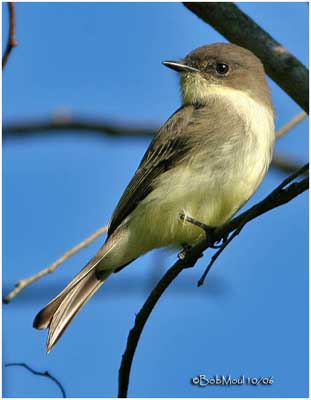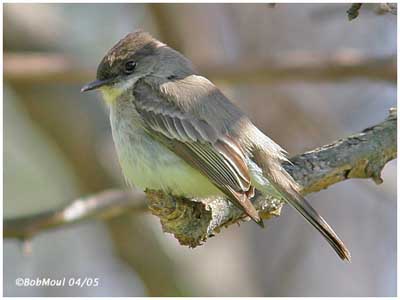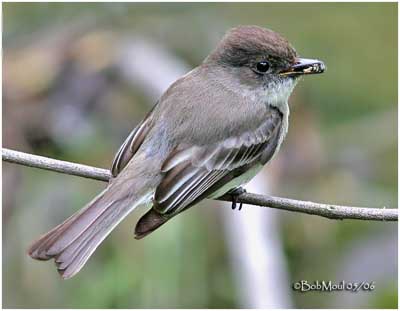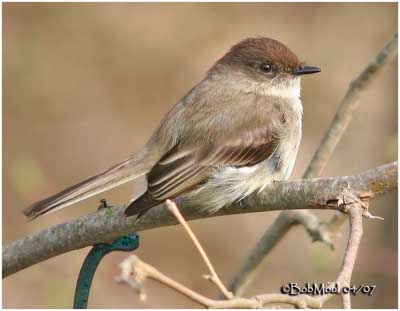
Eastern Phoebe
Sayornis phoebe
Passeriforme Order – Tirannidae Family
BIOMETRICS:
Length: 14-17 cm
Wingspan: 26-28 cm
Weight: 16-21 g
LONGEVITY: Up to 9 years
DESCRIPTION:
Eastern Phoebe has very black bill, eyes and legs, and long tail. It has relatively dark brown hood, wings and tail, offering a contrast with the dull brown of the remainder of the upperparts, and mostly fairly pure white underparts. The breast sides are dusky.
Autumn adult has light yellowish wash on the underparts.
DIET:
Eastern Phoebe feeds primarily on insects, such as flying insects, wasps, ants, flies, and wild bees. They eat also invertebrates such as grasshoppers, spiders, hair worms from the water, and small fishes and crustaceans in shallow water. It may eat some fruit and few seeds, when insects are less abundant.
PROTECTION / THREATS / STATUS:
Eastern Phoebe’s nest is strongly parasitized by brown-headed cowbird. Female cowbird removes Phoebe’s eggs, and its egg is rarely rejected by the Eastern Phoebe female.
Eastern Phoebe is very tolerant of human presence. Man-made structures as substitute nest sites have greatly facilitated their expansion across North America.
Fr: Moucherolle phébi
All : Weißbauch-Phoebetyrann
Esp : Mosquero Fibí
Ital : Febo orientale
Nd : Phoebe
Russe : Восточный феб
Sd : Grå fibi
Photographs by Bob Moul
His website :
Nature Photography
Text by Nicole Bouglouan
Sources:
A GUIDE TO THE BIRDS OF MEXICO AND NORTHERN CENTRAL AMERICA by Steve N. G. Howell, Sophie Webb - Oxford University Press - ISBN: 0198540124
FIELD GUIDE TO THE BIRDS OF NORTH AMERICA by National Geographic Society - National Geographic Society - ISBN: 0792274512
All About Birds (Cornell Lab of Ornithology)
Animal Diversity Web (University of Michigan Museum of Zoology)
What Bird-The ultimate Bird Guide (Mitchell Waite)
Wikipedia (Wikipedia, The Free Encyclopedia)


Juvenile shows two weak buffy wing bars and has more obvious yellow wash on underparts and browner tinge above.
Both sexes are similar, but male is larger and darker than female.
VOICE: SOUNDS BY XENO-CANTO
Eastern Phoebe’s call is a sharp, clear “chip” or “tsyp”. Song is a harsh, emphatic “fee-be”, with the second syllable harshest, rasping, or with a stuttered whistler second note “fee-b-be-bee”.
HABITAT:
Eastern Phoebe occurs in wooded or partly wooded habitats, almost always near rivers or streams, and along forest edges.
RANGE:
Eastern Phoebe breeds from SE Yukon and NE British Columbia, eastwards to Nova Scotia and S Quebec, southwards to C Texas, N Mississippi, and C Georgia.
It winters from Maryland, West Virginia, and very southern Illinois, and SE Oklahoma, southwards to Florida, the Gulf Coast and E Mexico.
BEHAVIOUR:
To feed, Eastern Phoebe has several manners: by flycatching, from a perch less than 10 metres off the ground; by chasing flying insects to the ground, by pouncing on insects on the ground, and picking them while hovering. Its most active period is the morning.
When is alighted on a perch, Eastern Phoebe sweeps its tail widely up and down, and then side to side.

Its migrations follow the insect emergence. It is a solitary bird, including when roosting, except during the breeding season. Even at this time, contact is only made during copulation; at other times, the male which attempts contact is aggressively rebuffed by female.
Male is using vocalizations to announce territory, but more often to attract a mate. Territorial disputes break out in the breeding season, involving vocalizations and chases, but rarely physical contact. It’s a highly territorial bird.
Easter phoebe is often sat in upright manner on exposed perches.
No recurrent courtship has been documented. Female always initiates copulation, only in the morning, during the male’s pre-dawn song. Eastern Phoebe keeps the same nest and the same mate for two broods.
Eastern Phoebe was probably the first banded bird. John James Audubon marked one in 1804, with a silver wire on the leg, and recorded its return the following year.
FLIGHT:
Eastern Phoebe wags its tail slowly after landing. Males perform flight display, circling and diving while singing.
REPRODUCTION:
Eastern Phoebe is monogamous and may raise two broods per season. After pair is formed, female chooses the nest site and builds the nest alone, while the male is near her, guarding its mate.
Nest is made with mud, moss and some leaves, and is lined with fine grass, stems and hair. They can use the nest several times, or those of another species, but never without renovating them first. They often build over old eggs or dead young. Nest is always built with cover overhead (bridges, buildings).
Seven to 14 days later, after the nest is complete, female lays 2 to 6 white eggs, with little glossy. Incubation lasts about 16 days, by female, and the male does not feed her while she incubates.
Chicks are able to flight at 15 days old, but they fledge only at 16 to 18 days. Both parents feed the young. Young can breed in their first year.
